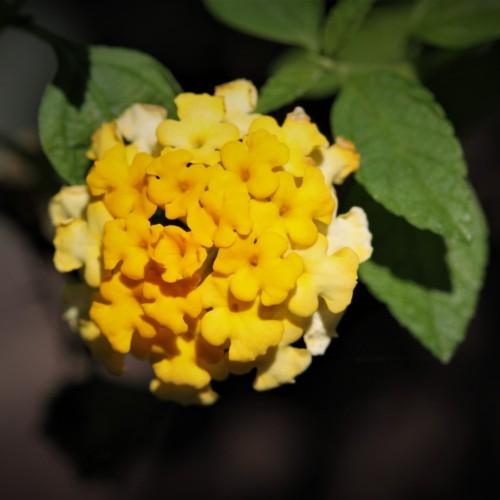
lantana
Lantana camara 'Balucgold' LITTLE LUCKY POT OF GOLD
Cycle:
Perennial
Watering:
Average
Hardiness Zone:
10 - 11
Flowers:
Flowers
Sun:
Full sun
Fruits:
Fruits Ready In Summer
Leaf:
Yes
Growth Rate:
Low
Maintenance:
Low
Poisonous To Pets:
Yes
Drought Tolerant:
Yes
Invasive:
Yes
Care Level:
Medium
watering
Water Little Lucky Pot of Gold lantana (Lantana camara 'Balucgold') weekly, allowing the top inch or 2 of soil to dry out between waterings. Water deeply to encourage deeper root growth, but never leave the pot sitting in water. Plant the lantana in well-drained soil, moving it to a pot with drainage holes or a location with good drainage if necessary.
sunlight
Lantana camara 'Balucgold' is a fast-growing plant species that requires at least 6 hours of direct sunlight each day in order to flourish. If planted in a location where it does not receive this level of sunlight, the plant may become weak and leggy or even die. Although this species often prefers full sunlight, dappled light or some partial shade can be beneficial during especially hot summer days. Regular watering and fertilization are also important to keep ‘Balucgold’ healthy and happy.
pruning
Pruning Lantana camara 'Balucgold' Little Lucky Pot of Gold should be done at least twice a year, in the late spring and early fall. Pruning will help to promote new growth and will help keep the plant tidy. When pruning, it is important to not cut more than 1-third of the total length of the stems and to remove only the tallest, oldest, and woodiest stems. This type of lantana typically grows in a mounded shape with a moderate spread, so it is best to keep it trim and neat.
FAQ
Is Lantana a perennial plant?
Yes, Lantana is a perennial plant. It grows to be between one and three feet tall and is known for its showy and fragrant flowers in colors such as yellow, orange, pink, and white. Lantana is drought-tolerant and typically blooms from mid-summer through the fall. It can tolerate partial shade but prefers full sun for the best blooms and foliage. Because of its hardy nature, Lantana is perfect for landscape borders, patio containers, and hanging baskets.
Could Lantanas be grown as a hedge?
Yes, lantanas can be grown as a hedge. Since lantanas have an mounding habit, as they mature they form a thick, dense hedge which makes them an ideal plant for hedges. Plant lantanas in well-draining, nutrient-rich soil and full sun. In addition, pruning them regularly can help to maintain the shape and the vigor of the hedge. The evergreen foliage also helps provide year-round appeal. Lantanas, however, are considered invasive in some areas, so check with your local Cooperative Extension for the most current information before planting.
Do Lantanas have a strong fragrance?
No, lantanas do not have a strong fragrance. The flowers are usually described as having a light, sweet scent that is most noticeable when smelled up close. Lantanas also attract butterflies and hummingbirds which may be able to appreciate the delicate fragrance more than a human.
Is Lantana considered an invasive species?
Yes, Lantana is considered an invasive species in many parts of the world. It is native to tropical regions in the Americas, but has been introduced to many other areas as an ornamental plant. In these new areas, Lantana can easily spread and out-compete native vegetation, leading to decreased species diversity. In some countries it is even listed as a noxious weed. In addition to impacting native species, the plant produces a toxin that can harm livestock and cause skin irritation in humans. As a result, it is important to take steps to remove and control Lantana to protect native ecosystems.
Could Lantanas be grown indoors?
Yes, lantanas can be grown indoors but they don't do as well as if they were grown outdoors. Artificial lighting will work for growing lantanas indoors but it should be kept in bright light for at least 4-6 hours each day for the best results. Also, be sure to keep the plants in a warm room and make sure they are properly watered. With a bit of effort, lantanas can be grown indoors and can even produce a few flowers.
Could Lantanas be used in butterfly gardens?
Yes, lantanas can be used in butterfly gardens. Not only do lantanas add a pop of colour to the garden, but they are also an important source of nectar for butterflies and other pollinators. Planting a variety of different lantana cultivars can help provide a steady food source for butterflies throughout the season. Lantanas come in a variety of shapes, sizes, and colours, and they require minimal upkeep. Planting a few of these tough, drought-tolerant plants in a sunny location can help create a stunning and beneficial butterfly garden.
Are Lantanas self-seeding plants?
Yes, lantanas are self-seeding plants. This means that when they flower and produce seeds, those seeds can take root and germinate into new plants. Lantanas are quick to reseed, meaning that you can expect an abundance of new seedlings in the spring after a successful flowering season in the summer. It's important to keep in mind, however, that these plants can be quite invasive and need to be kept from spreading too much. Picking off the flowers before they go to seed is the best method of controlling spread.
Could Lantanas be used in container gardens?
Yes, Lantanas can be used in container gardens! With their bright colors and easy-going nature, they are perfect to use as colorful focal points for a container garden. They prefer well-drained soils and need plenty of sunshine, so make sure the pot has good drainage and is exposed to full sun. They can also tolerate short dry spells, as long as the soil remains fairly moist. With their long blooming season and range of colors, they make a great addition to any container garden.
